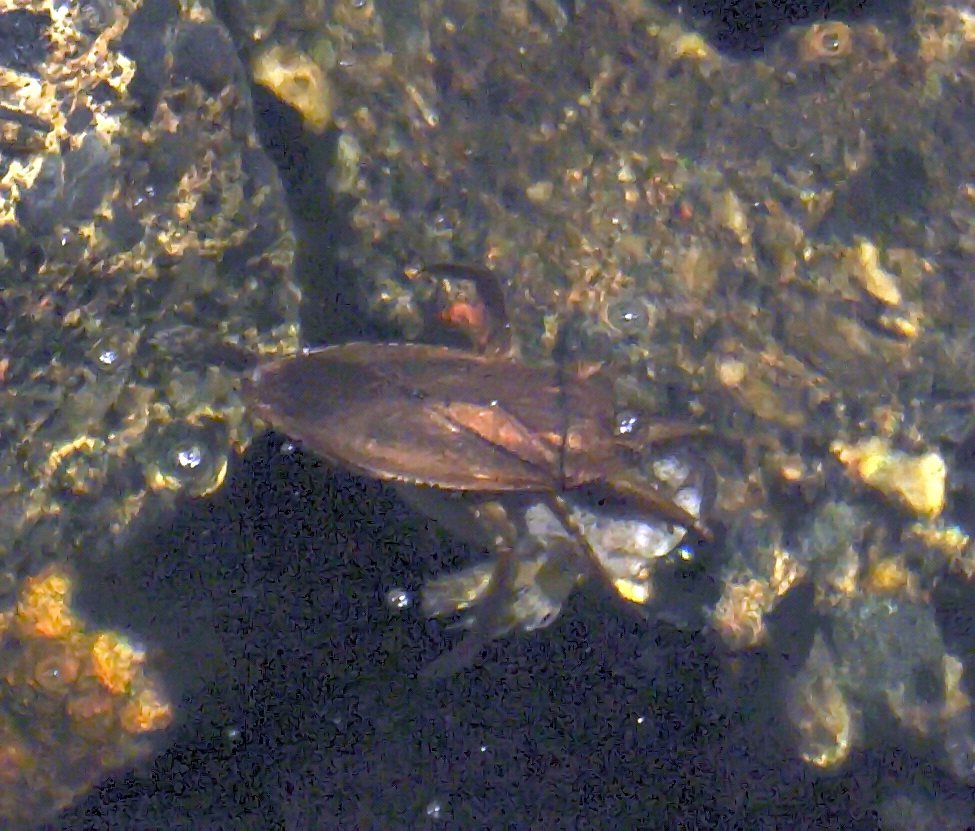Far North Friday #75: Big, ugly, and It Bites
There it was, in the water bucket. It was big (from a water insect perspective), ugly (apologies), and I read it bites! It looked right back at me waving its scary front limbs at me. I had never seen one of these before. It was a Giant Water Bug (Photo 1).
Photo 1: American giant water bug (Lethocerus americanus), sadly, dead on the parking lot of a retail store. Photo composed by Andy Fyon, Oct 15/17.
We had flown into a frozen lake far north lake in late winter and set up our bush camp. Our water source was the frozen lake.
Getting water from the lake is not new to those who live in the far north. Our technique was simple: a) clear the snow off an a metre-square area of ice away from the shore; b) chop a hole through the ice big enough to accommodate a galvanized metal bucket; c) cover the hole with a sheet of plywood; d) dip the bucket into the lake to collect water; and e) shovel snow back on to the plywood to insulate the hole from refreezing between visits. Each visit to the water hole required shoveling off the snow insulation, sliding off the plywood to expose the water hole, and chopping away any ice that had formed since the last visit. It went without saying it was “bad” if you accidentally lost the bucket down the hole.
We had two buckets. but, anticipating we would accidentally lose a bucket, we had an experiment planned. The unfortunate person who lost the bucket would count the seconds before the bucket sank out of sight. In theory, there is a relationship between the length of time before the bucket disappears from sight, the depth of water, and the clarity of the lake water. We had a geologist’s secchi disk test! We felt clever. In reality, we had no idea how to figure out the formula. Fortunately, we never lost a bucket so we never had work on that formula. It was a dark water lake anyway.
I have seen less than five Giant Water Bugs in my life. Its scientific name is Lethocerus americanus. Its nick name name is “toe-biter”. You don’t need much of an imagination to relate to the informal name. They capture their food using the scary front limbs (Photo 2). They kill their victim by injecting a poisonous digestive liquid into their prey and then suck it dry! It eats tadpoles, small fish, insects, and other arthropods. A human may receive a painful bite the giant water bug is handled or disturbed, but it prefers to avoid humans. It does fly and one of my encounters was during the summer, on land, well away from a lake (Photo 1). Apparently adults die over winter, despite my observation in the frozen lake.
Photo 2: (terrible photo) A giant water bug with what appears to be a small minnow, or perhaps a large tadpole, in its front limbs. The giant water bug was feeding. Photo composed at Fairbanks Provincial Park, Ontario, Canada. Photo composed by Andy Fyon, Oct. 11/08.
I had no intent to hurt the giant water bug I saw in the frozen lake, but I did muse about delivering the bug to the camp as a joke, but it would have been killed. I dumped it back into the lake and in less than 3 seconds, it slipped into the darkness - a bug secchi test. It was big, ugly, and I did not test its bite, but it did make me wonder what other “monsters” might live in that dark water lake.
Andy Fyon: Feb. 18/22; Facebook: Feb. 18/22


